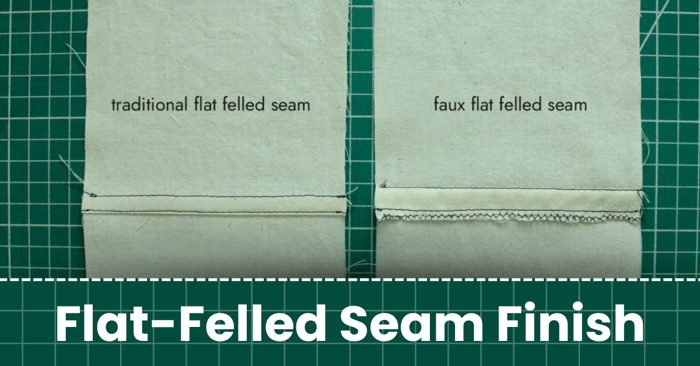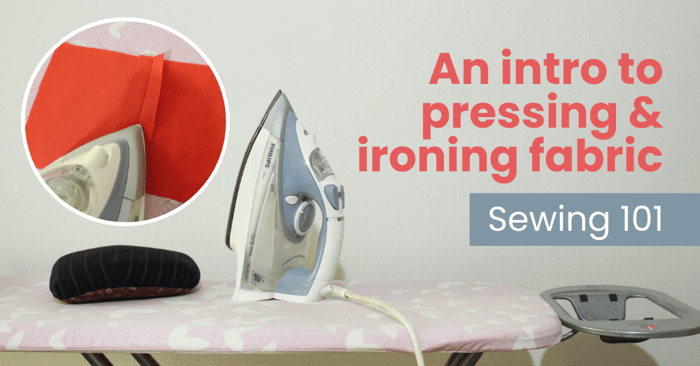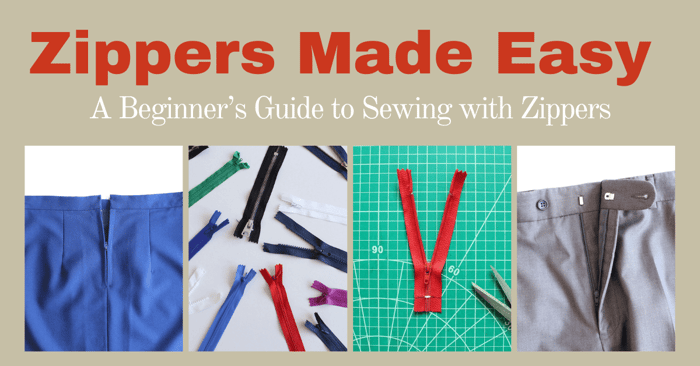
Guide to Thread for Sewing
Choosing the right thread for sewing is just as important as selecting the right fabric and needle for your sewing projects. With so many thread types available, it can be overwhelming for beginners to know which one to use.
In today’s article, we will explore everything you need to know about thread for sewing and its types, how to read a thread spool, how to choose the right thread for your sewing project, thread brands to try out, and many other tips on how to nail the thread type so that your sewing project is a success.
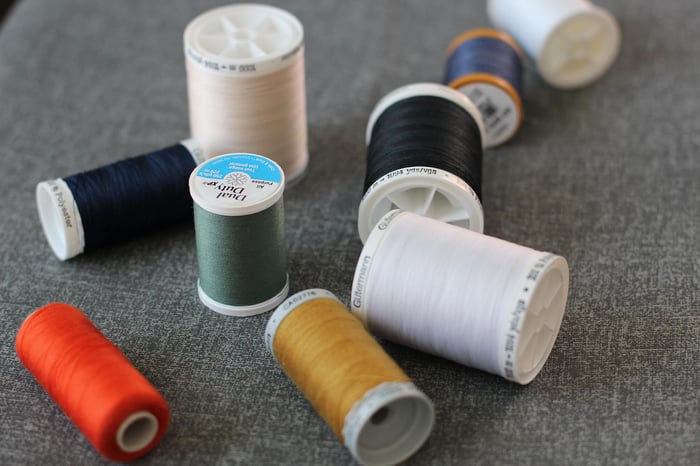
Anatomy of thread
Before we dive into thread types, uses, and more, it’s important to talk a bit about thread anatomy and the main thread components.
Fiber refers to the type of material the thread is made of. Some of the most common fibers are cotton, rayon, polyester, and silk.
Weight & thickness—Threads are categorized by weight (e.g., 30wt, 50wt) or denier/tex systems, influencing stitch appearance and strength.
Twist & ply—Twist refers to how the individual fibers are twisted together to form a single strand of thread. Ply refers to the number of individual strands twisted to make the thread.
Finish refers to any treatment that is applied to the thread. Treatments such as mercerization (for cotton) or lubrication improve smoothness, durability, and luster.
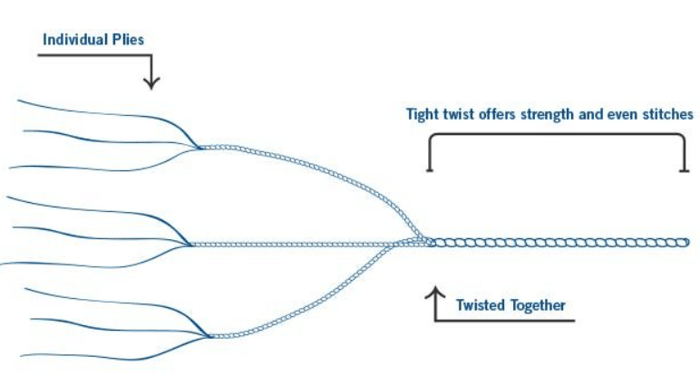
Diagram taken from www.superiorthreads.com
Thread for Sewing Types and Uses
Natural fiber threads
Natural fiber threads are made from organic materials such as cotton, silk, wool, and linen. They’re known for their softness, breathability, and compatibility with natural fabrics. Natural fiber threads are biodegradable and eco-friendly but can be more susceptible to wear, moisture, and UV damage compared to synthetic threads. They are best suited for projects requiring a natural look and feel, especially when sewing with cotton, linen, or silk fabrics.
Cotton thread is the most common natural fiber thread, available in different types such as mercerized (for added strength and sheen) and all-purpose cotton. It has little stretch, making it ideal for quilting, heirloom sewing, and lightweight woven fabrics.
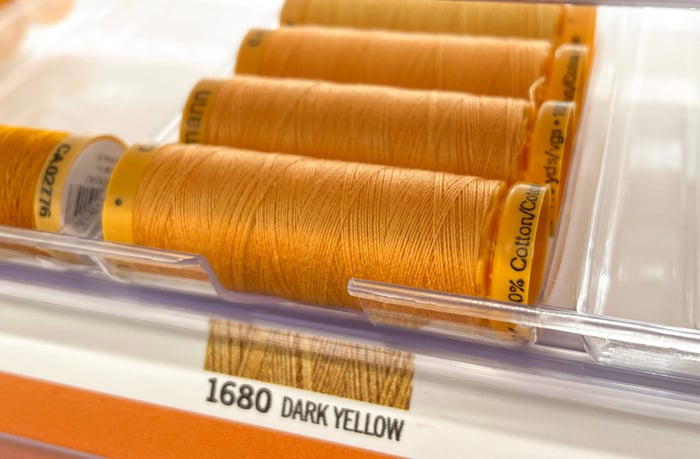

Silk thread is strong, smooth, and naturally elastic, making it perfect for delicate fabrics like silk and wool. It is often used in couture sewing and fine embroidery.
Linen thread is made from natural linen fibers, and it’s known for its strength. As a result, it is used for sewing heavyweight fabrics.
Synthetic fiber threads
All-purpose polyester thread is the most commonly used synthetic fiber thread. Made from synthetic polyester fibers, this thread is strong, smooth, resistant to shrinking, and has slight elasticity, making it ideal for both hand and machine sewing.
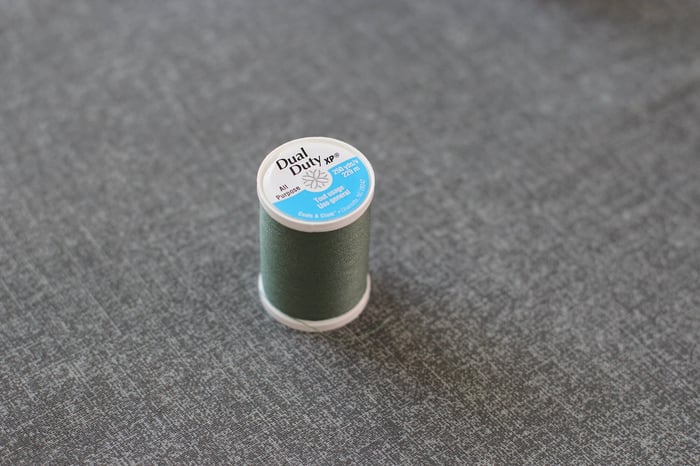
Unlike cotton, polyester thread does not weaken when wet, and it’s perfect for outdoor and heavy-duty applications. It’s commonly used for garments, quilting, and general sewing projects, while heavy-duty versions are suited for upholstery, denim, and leather.
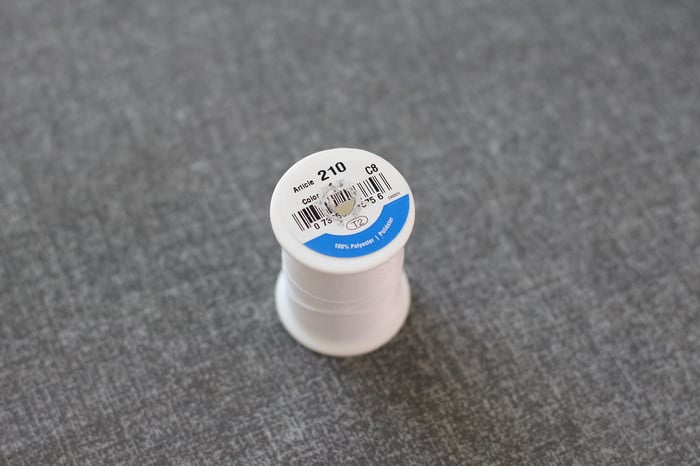
Keep in mind that synthetic fibers such as polyester thread will not take the color. Choose a thread that is a similar color if you’re planning to dye fabric. Otherwise, the best option is to use cotton thread.
Nylon thread, on the other hand, is used for sewing leather, canvas, and vinyl. It has strength and durability, which is important for sewing heavy-duty projects. It comes in many different weights, from thin, like an invisible thread, to thick.
Rayon thread on the other side is made from rayon, a semi-synthetic fiber derived from natural cellulose (typically wood pulp). Rayon is known for its smooth, silky texture and it’s a popular choice for embroidery, decorative stitching, and quilting.

Other threads
Embroidery thread
Embroidery thread is a specialized thread designed for decorative stitching. It can be used in both hand and machine embroidery. Various materials, including rayon, polyester, cotton, silk, and metallic fibers, offer unique qualities.
Rayon embroidery thread is popular for its high sheen and smooth texture, making it ideal for vibrant, decorative stitching. Cotton embroidery thread provides a matte, natural finish and works well for traditional embroidery techniques like cross-stitch. Silk thread, though luxurious and strong, is less commonly used due to its cost.
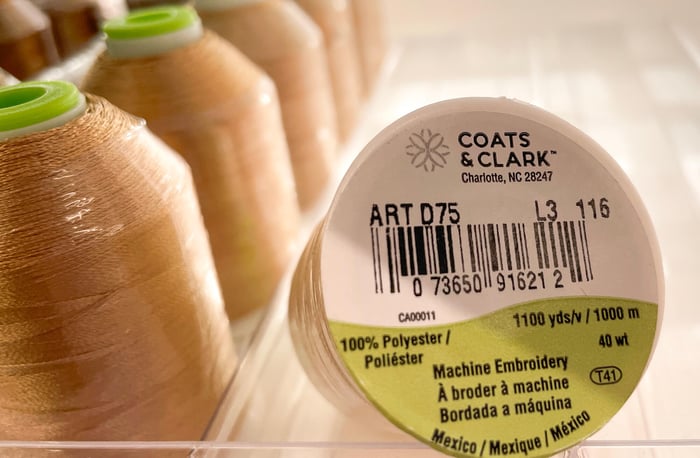
Elastic Thread: This type of thread is great for gathering and shirring fabric due to its high stretch and rebound.
Serger thread: Serger thread is a type of thread designed for use in sergers (also known as overlock machines). This thread is typically finer, smoother, and more durable than regular sewing thread.
Jeans/Denim thread: this is a poly-cotton blend that gives a thick, strong, and robust thread that is used to topstitch details on denim projects such as pockets, felted seams, zippers, belt loops, and more.
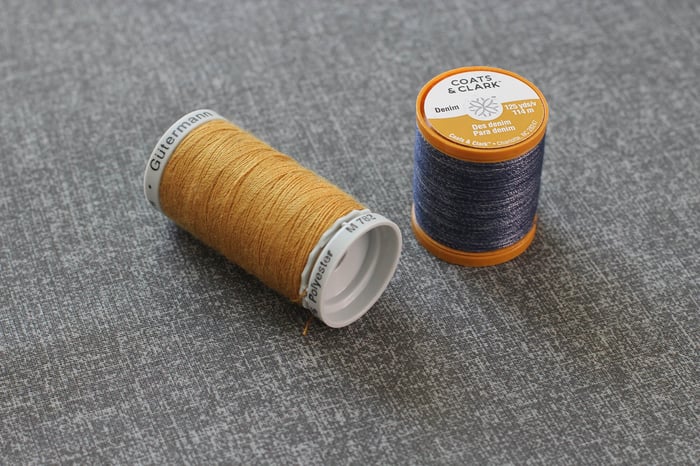
Thread size classification
Some of the units used for classifying thread sizes are Weight (wt), Denier (den), and Tex.
The weight of the thread is usually indicated on the spool and follows a numerical system where lower numbers indicate thicker threads and higher numbers indicate thinner threads. Depending on the brand, the thread weight sometimes is followed by a slash and a number. The number signifies the number of individual strands of thread that are twisted together to make the final thread.
- 50wt (Lightweight) – Suitable for fine fabrics like chiffon and silk.
- 40wt (Medium-weight) – Commonly used for general sewing and quilting.
- 30wt (Heavy-weight) – Ideal for topstitching and decorative work.
- 20wt (Extra Heavy-weight) – Used for upholstery, leatherwork, and denim.
Denier is another unit used to measure thread weight, where larger numbers mean thicker and heavier threads. Denier is often used on embroidery threads.
TEX measures thread density, and the finer the thread, the lower the TEX number.
NOTE: All of these units and numbers may cause some confusion, especially for a beginner. So, most beginners will find 40wt polyester or cotton thread to be the most versatile and easy to work with. And if we were to convert it to tex, it would be tex 25, and in denier, denier 225.
This is why it’s important to research specific brands in advance, define their weight system, and buy the thread that you really need. There are cases when certain threads are not marked with size but by application and fiber.

Gutterman is one of the brands where you buy based on fiber and use.
Another detail when shopping for thread is checking the amount stated in ‘meters’ or ‘yards’.
How do you choose the right thread for your sewing project?
Choosing the right thread for your sewing project mainly depends on the fabric choice.
- Match the fabric choice—where for lightweight fabrics use thinner threads and for medium to heavyweight fabrics thicker threads. Not necessary, but you can always match natural fabrics such as cotton and linen with cotton threads, and for blended polyester fabrics, use polyester threads.
- Choose a sewing needle in line with the thread and fabric weight. Similar to thread, sewing needles come in different sizes but also types used for specific fabrics.
- Always buy the best thread you can afford. Longevity and the construction of your garments depend on the thread to keep everything together.
Why does thread quality matters?
Thread quality matters because it directly affects the durability, appearance, and overall longevity of your sewing projects. Investing in high-quality thread is essential to sew strong and durable stitches, ensure smooth and even stitching, and produce less lint buildup.
At the end of the day, none of us want to deal with thread tension issues, thread shredding, and breaking, so finding an affordable and qualitative thread brand is a must to ensure the quality of your sewing projects.
Thread brands
Not all threads are created equally that is why based on your budget you always choose quality over quantity. Some of the well-known thread brands include:
- Gutermann – A popular choice for high-quality polyester and cotton threads.
- Mettler – Well-regarded for quilting and embroidery threads.
- Aurifil – Excellent for quilting with low-lint cotton threads.
- Coats & Clark – Widely available and great for general sewing.
Sewing Thread Tips
- Keep in mind to avoid cheap, no-brand threads since those are the ones that have the lowest quality.
- Thread does have a shelf life, so take into consideration that buying thread second-hand might not always be a good idea. Old thread breaks easily, brittles, and causes quite some lint on your sewing machine.
- Do not use serger thread on your sewing machine. It won't give you neat seams, and it will cause lint buildup since it’s made differently.
- Buy the best brand you can afford. Your machine will love it, and your garment will end up looking neat and professional.
- Give each thread brand a decent try and define what works best for your sewing machine.
- Choose a thread color that is either the same color as your fabric or slightly darker, as the stitched seam often appears slightly lighter than the thread itself, making a darker shade blend in better.
Final thoughts
As a beginner, your ability to understand and choose the appropriate thread for your project will improve with practice. Your projects' longevity and look will be greatly impacted by the type, weight, and quality of the thread you use. Making the effort to select the appropriate thread will ultimately make all the difference and result in minimal future repairs, whether you're sewing, embroidering, or quilting.
Thank you for joining us today to learn more about thread for sewing! Before you leave, make sure to sign-up for our newsletter below. You can also join our Facebook Group or follow us on Instagram. Happy Sewing!

